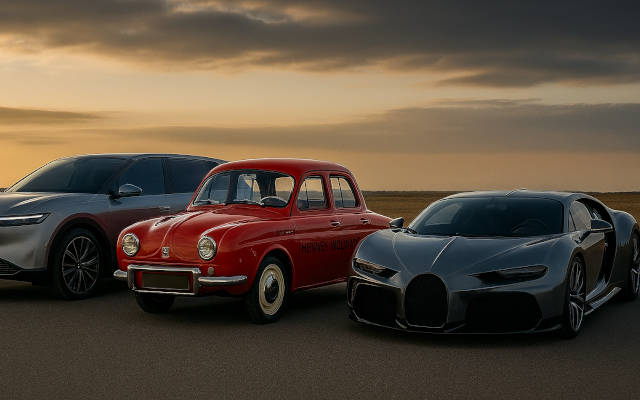When Speed Sucks - The Quiet History of Vacuum Cleaner EVs

The vaccum cleaner EV trio left-to-right: Dyson N526, Henney Kilowatt, Dreame Technology
By EVWorld.com Si Editorial Team
How three vacuum empires tried to reinvent the electric car - and why only one might still succeed.
It's not every day you find a vacuum cleaner company trying to build a car. But over the past century, three such brands - Henney (via Eureka), Dyson, and Dreame Technology - have each taken a swing at the electric vehicle market. Their stories span Cold War optimism, billion-pound moonshots, and hypercar fantasies. And while none have yet succeeded commercially, their attempts reveal something deeper: a belief that the future of mobility might just be hiding in your broom closet.
The Kilowatt That Couldn’t
In 1959, the Henney Kilowatt rolled onto American roads with a whimper, not a roar. Built on a Renault Dauphine chassis and retrofitted with a 36-volt electric drivetrain, the Kilowatt was the brainchild of the National Union Electric Company—parent to both Henney Motor Company and Eureka, the vacuum cleaner brand.
The conversion took place in Canastota, New York, where Henney’s coachbuilding facility transformed imported French chassis into American electric curiosities. The Dauphines arrived as gliders—stripped of their internal combustion engines—ready for electrification. Engineers installed battery trays, transistor-based speed controllers, and propulsion systems developed in collaboration with Caltech’s Victor Wouk.
Why the Dauphine? Henney needed a lightweight, compact platform that could accommodate batteries without major structural changes. The Volkswagen Beetle was a tempting alternative, but its two-door layout and tighter interior made it less practical for fleet use. The Dauphine, with four doors, a rear-engine layout, and a cooperative supplier in Renault, was the pragmatic choice.
- Production: Fewer than 47 units (1959–1960)
- Top Speed: ~40 mph (36V); ~60 mph (72V)
- Acceleration: 0–30 mph in ~10 seconds
- Range: ~40–60 miles
- Target Market: Utility companies and municipal fleets
- Price: $3,600 (≈ $38,600 today)
Dyson’s Half Billion-Pound Detour
Fast-forward to 2017, and Sir James Dyson—Britain’s vacuum king—announced his company’s secret EV project: the N526. It was a seven-seat SUV with a 600-mile range, solid-state battery ambitions, and a price tag north of £150,000. Dyson poured over £500 million into the venture, converting a former military airfield in Hullavington, Wiltshire into a sprawling R&D campus.
The N526 was sleek, low-slung, and packed with innovations: 24-inch wheels for efficiency, posture-optimized seats, and a minimalist interior that looked more spaceship than SUV. But by 2019, Dyson pulled the plug. The reason? Economics. Unlike legacy automakers, Dyson had no gas-powered lineup to subsidize EV losses. Building everything in-house—from motors to batteries—proved too costly.
This proprietary approach wasn’t just about control—it was about protecting intellectual property. Dyson feared supply chain leaks and reverse engineering. By designing every component internally, he hoped to preserve innovation and brand purity. It was a bold, Apple-like strategy—but without Apple’s scale or margins, it became commercially untenable.
- Production: 3 prototypes; no commercial release
- Top Speed: ~125 mph
- Acceleration: 0–60 mph in 4.8 seconds
- Range: ~600 miles (projected)
- Target Market: Ultra-premium EV buyers
- Price Target: £150,000 (~$190,000)
Dreame’s Hypercar Fantasy
Now, Dreame Technology—a Chinese brand best known for high-RPM vacuum motors—is stepping into the EV ring. And it’s not aiming low. Dreame’s first car is a Bugatti-esque hypercar with coach doors, aerospace-grade steel, and a torsional stiffness that rivals race cars. The company plans to debut a prototype at CES and begin production by 2027.
Unlike Dyson, Dreame is leaning into China’s aggressive push for EV dominance. It’s scouting factory sites near Tesla’s Berlin Gigafactory and has assembled a team of nearly 1,000 specialists. The brand will operate under two sub-labels: Dreame Auto for hypercars and Star Auto for luxury sedans.
- Production: Prototype expected 2025; launch by 2027
- Top Speed: Projected 200+ mph
- Acceleration: 0–60 mph in ~2.5 seconds
- Range: TBD; likely 300–400 miles
- Target Market: Ultra-luxury performance buyers
- Price Target: TBD; likely $250,000+
Why Vacuums Keep Trying
Despite their domestic origins, these companies share core competencies that make EVs a tempting frontier:
- Motor Expertise: High-RPM, compact motors are central to both vacuums and EVs.
- Battery R&D: Appliance-grade battery tech offers a foundation for automotive innovation.
- Brand Expansion: EVs offer prestige and diversification beyond household goods.
From the red-glossed Kilowatt to Dyson’s ghost SUV and Dreame’s gleaming hypercar renderings, the road from suction to speed is paved with ambition, engineering, and a touch of madness. And maybe, just maybe, the next great EV won’t come from Detroit or Stuttgart—but from the motor that once cleaned your living room.
Learn More
- Dyson’s official statement on the N526 EV project
- Henney Kilowatt archive at the EV Museum
- Autocar: Inside Dyson’s electric car project
- Dreame Auto official site
- Curtis Instruments – EV speed controller supplier
- Caltech tribute to Victor Wouk
Original Backlink
Views: 84
Articles featured here are generated by supervised Synthetic Intelligence (AKA "Artificial Intelligence").
